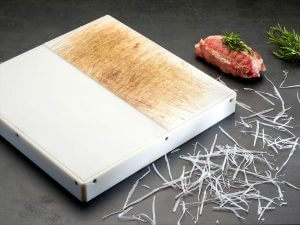We all have at least one in the kitchen, yet few know the fascinating history hidden behind the common cutting board. This tool, so essential in the preparation of everyday foods, conceals centuries of evolution, adaptations, and curiosities that go well beyond its apparent simplicity.
Where Did Cutting Boards Originate?
The origin of the cutting board is lost in the mists of time, when humans began to develop tools that allowed them to prepare food in a more effective and hygienic manner. Although there are no documents that precisely attest to the exact moment of its invention, it is plausible that the use of flat surfaces to cut or work food is almost as old as the use of cutting utensils themselves. Initially, these “surfaces” could have simply been smooth stones or wooden logs.
How Have They Evolved?
Through the centuries, cutting boards have undergone significant transformations. From simple pieces of wood or stone, we have moved to increasingly sophisticated materials and technologies. In the Middle Ages, for example, wooden cutting boards became common in more affluent households, often carved with decorations that testified not only to their practical use but also to a certain social status.
With the advent of industrialization, materials such as glass and ceramic made their appearance, although wood remained a favorite for a long time due to its qualities of durability and hygiene, thanks to its ability to absorb shocks without damaging the blades of knives.
In the 20th century, with the discovery and spread of new synthetic materials, plastic and polyethylene cutting boards came into the scene, appreciated for their durability, ease of cleaning, and lesser impact on knife blades.
Why Are They So Important?
The cutting board is not just a tool for cutting, but a key element for food safety. The ability to separate raw foods from cooked ones on different surfaces has a significant impact on the prevention of cross-contamination. The diversification of materials has also made it possible to adapt the cutting board to specific food uses, improving hygiene and functionality in the modern kitchen.
The Evolution Continues
Today, Euroceppi srl carries on the tradition and innovation in the field of polyethylene and wood cutting boards and blocks. Founded in 1922 from the merger of two pre-existing realities, Euroceppi has transformed the family business into an art that is passed down from generation to generation, establishing itself as a leader in the market of professional cutting boards. Committed to a continuous program of investments in people and technology, our company represents a point of reference for those looking for high-quality products, made respecting traditional production processes but with an eye always attentive to modern needs.
With a constant commitment to quality and innovation, Euroceppi is not only a witness to the history of the cutting board but also an active protagonist, ready to respond to the challenges of the future.
Discover more about our story and our products.



